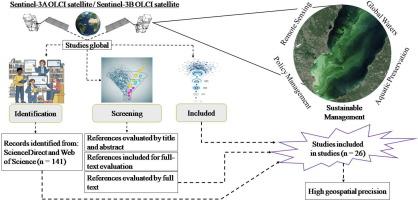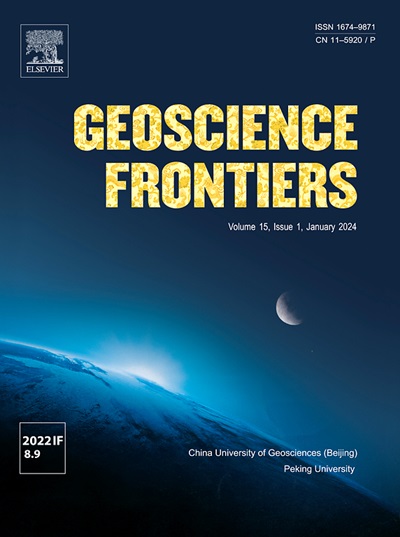Strategic use of Sentinel-3A/B OLCI data for global water quality management: An overview
IF 8.9
1区 地球科学
Q1 GEOSCIENCES, MULTIDISCIPLINARY
引用次数: 0
Abstract
The Sentinel-3A/B satellites, operated by the European Space Agency (ESA), are equipped with the Ocean and Land Color Instrument (OLCI), which provides data through push-broom radiometers. Sentinel-3A was launched on February 16, 2016, and Sentinel-3B on April 25, 2018. Given their relevance in environmental monitoring, there is a growing need for literature reviews to deepen the functional understanding of their geospatial applications. This study aims to review the scientific literature on using Sentinel-3A/B OLCI data for monitoring aquatic environments, particularly focusing on chlorophyll-a (CHL), total suspended matter (TSM), and absorption of dissolved organic matter at 443 nm (ADG443). The review includes publications indexed in the Scopus and Web of Science (SCIE) databases between February 2016 and 2025. The Preferred Reporting Items for Systematic Reviews and Meta-Analyses (PRISMA) methodology was employed to select 26 relevant studies that apply spectral detections via Sentinel-3A/B satellites related to levels of CHL, TSM, and ADG443. Additionally, the Content Analysis Method (CAM) and MAXQDA software were used to analyze absolute (AF) and relative frequencies (RF) of key variables such as study location, sampling, objectives, use of Sentinel satellites, outcomes, innovations, and future research directions. CAM results showed an average frequency of ∼ 36.0%, with Sentinel-3A accounting for 35.3% and Sentinel-3B ranging between 31.89% and 40.08%. Chlorophyll-a was the most frequently cited term, with a frequency of 32.33% to 40.08% in MAXQDA. The consistency and reliability of spectral detections underscore the potential of these satellites to support the aquatic ecosystem preservation.

Sentinel-3A/B OLCI数据在全球水质管理中的战略应用综述
Sentinel-3A/B卫星由欧洲航天局(ESA)运营,配备了海洋和陆地颜色仪器(OLCI),它通过推扫帚辐射计提供数据。哨兵- 3a卫星于2016年2月16日发射,哨兵- 3b卫星于2018年4月25日发射。鉴于它们在环境监测中的相关性,越来越需要文献综述来加深对其地理空间应用的功能理解。本研究旨在综述利用Sentinel-3A/B OLCI数据监测水生环境的科学文献,重点关注443 nm处叶绿素-a (CHL)、总悬浮物(TSM)和溶解有机质吸收(ADG443)。该综述包括2016年2月至2025年期间在Scopus和SCIE数据库中检索的出版物。采用系统评价和荟萃分析的首选报告项目(PRISMA)方法选择了26项相关研究,这些研究利用Sentinel-3A/B卫星进行与CHL、TSM和ADG443水平相关的光谱检测。此外,利用内容分析法(Content Analysis Method, CAM)和MAXQDA软件分析了研究地点、采样、目标、Sentinel卫星的使用、结果、创新和未来研究方向等关键变量的绝对频率(AF)和相对频率(RF)。CAM结果显示平均频率为~ 36.0%,其中Sentinel-3A占35.3%,Sentinel-3B占31.89% ~ 40.08%。在MAXQDA中,叶绿素-a被引频次最高,为32.33% ~ 40.08%。光谱检测的一致性和可靠性强调了这些卫星在支持水生生态系统保护方面的潜力。
本文章由计算机程序翻译,如有差异,请以英文原文为准。
求助全文
约1分钟内获得全文
求助全文
来源期刊

Geoscience frontiers
Earth and Planetary Sciences-General Earth and Planetary Sciences
CiteScore
17.80
自引率
3.40%
发文量
147
审稿时长
35 days
期刊介绍:
Geoscience Frontiers (GSF) is the Journal of China University of Geosciences (Beijing) and Peking University. It publishes peer-reviewed research articles and reviews in interdisciplinary fields of Earth and Planetary Sciences. GSF covers various research areas including petrology and geochemistry, lithospheric architecture and mantle dynamics, global tectonics, economic geology and fuel exploration, geophysics, stratigraphy and paleontology, environmental and engineering geology, astrogeology, and the nexus of resources-energy-emissions-climate under Sustainable Development Goals. The journal aims to bridge innovative, provocative, and challenging concepts and models in these fields, providing insights on correlations and evolution.
 求助内容:
求助内容: 应助结果提醒方式:
应助结果提醒方式:


